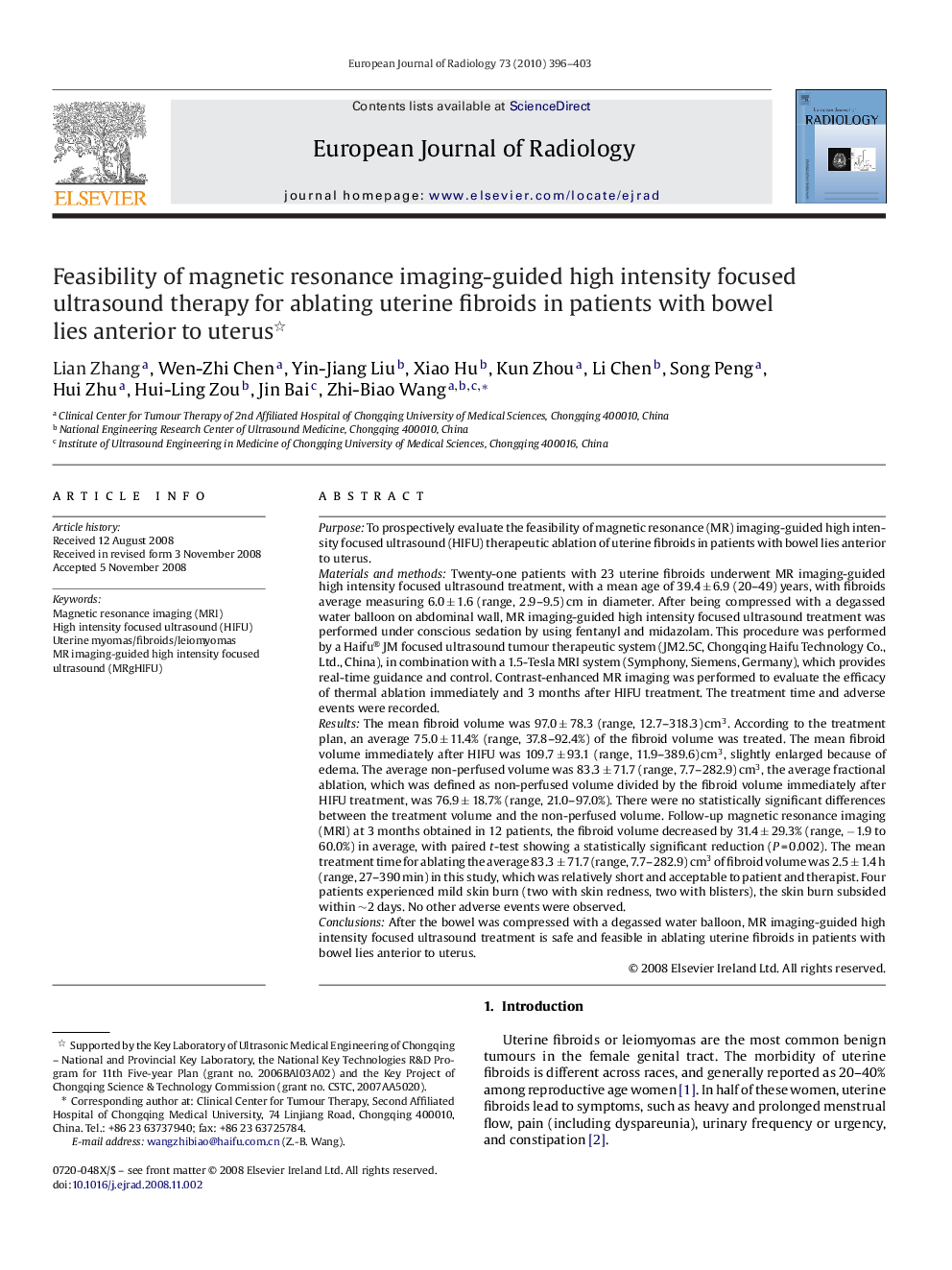| کد مقاله | کد نشریه | سال انتشار | مقاله انگلیسی | نسخه تمام متن |
|---|---|---|---|---|
| 4226562 | 1609818 | 2010 | 8 صفحه PDF | دانلود رایگان |

PurposeTo prospectively evaluate the feasibility of magnetic resonance (MR) imaging-guided high intensity focused ultrasound (HIFU) therapeutic ablation of uterine fibroids in patients with bowel lies anterior to uterus.Materials and methodsTwenty-one patients with 23 uterine fibroids underwent MR imaging-guided high intensity focused ultrasound treatment, with a mean age of 39.4 ± 6.9 (20–49) years, with fibroids average measuring 6.0 ± 1.6 (range, 2.9–9.5) cm in diameter. After being compressed with a degassed water balloon on abdominal wall, MR imaging-guided high intensity focused ultrasound treatment was performed under conscious sedation by using fentanyl and midazolam. This procedure was performed by a Haifu® JM focused ultrasound tumour therapeutic system (JM2.5C, Chongqing Haifu Technology Co., Ltd., China), in combination with a 1.5-Tesla MRI system (Symphony, Siemens, Germany), which provides real-time guidance and control. Contrast-enhanced MR imaging was performed to evaluate the efficacy of thermal ablation immediately and 3 months after HIFU treatment. The treatment time and adverse events were recorded.ResultsThe mean fibroid volume was 97.0 ± 78.3 (range, 12.7–318.3) cm3. According to the treatment plan, an average 75.0 ± 11.4% (range, 37.8–92.4%) of the fibroid volume was treated. The mean fibroid volume immediately after HIFU was 109.7 ± 93.1 (range, 11.9–389.6) cm3, slightly enlarged because of edema. The average non-perfused volume was 83.3 ± 71.7 (range, 7.7–282.9) cm3, the average fractional ablation, which was defined as non-perfused volume divided by the fibroid volume immediately after HIFU treatment, was 76.9 ± 18.7% (range, 21.0–97.0%). There were no statistically significant differences between the treatment volume and the non-perfused volume. Follow-up magnetic resonance imaging (MRI) at 3 months obtained in 12 patients, the fibroid volume decreased by 31.4 ± 29.3% (range, −1.9 to 60.0%) in average, with paired t-test showing a statistically significant reduction (P = 0.002). The mean treatment time for ablating the average 83.3 ± 71.7 (range, 7.7–282.9) cm3 of fibroid volume was 2.5 ± 1.4 h (range, 27–390 min) in this study, which was relatively short and acceptable to patient and therapist. Four patients experienced mild skin burn (two with skin redness, two with blisters), the skin burn subsided within ∼2 days. No other adverse events were observed.ConclusionsAfter the bowel was compressed with a degassed water balloon, MR imaging-guided high intensity focused ultrasound treatment is safe and feasible in ablating uterine fibroids in patients with bowel lies anterior to uterus.
Journal: European Journal of Radiology - Volume 73, Issue 2, February 2010, Pages 396–403